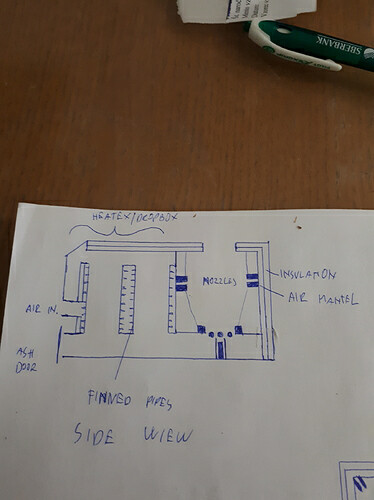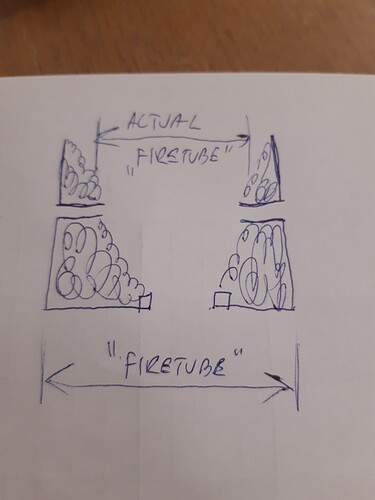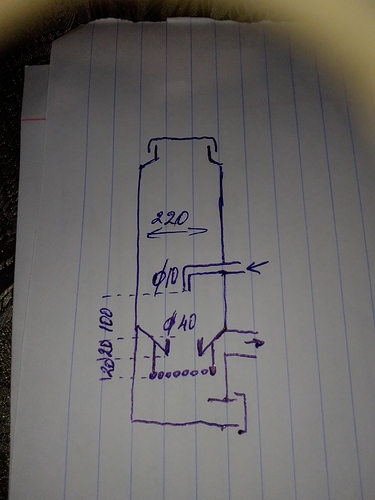Wet wood in a gasifier is really not welcome, energy for pyrolysis and reduction is lost to drying the wood and evaporating the water, which is then cooled and condensed, literally discarding some of the energy from the high temperature. Kristjan and I talked about it and our goal is to retain as much energy as possible with the high temperature in the carburetor, hence the double coat and the outside insulated to the top. I intend to cool the hot outlet line in a heat exchanger, where it would overheat the air for total wood drying before entering the gasifier.
Good morning Tone .
I agree with you 100%
What I was showing in the above video is if caught in an emergency I can still go even if no dry wood is available. .
I try to use wood as dry as I can get it .
Hello Wayne, I admire your work. I am thinking about the construction of a heat exchanger, hot wood gas / air for drying chips, and before entering the funnel, I am wondering what is the temperature of wood gas usually at the outlet
Hello Tone and thanks much for the kind words .
I consider 800F to be the normal gas temperature leaving the gasifier and before the gas reaches the heat exchanger.
I got two cast iron drums from the brakes of a smaller truck with a diameter of 300mm from a neighbor, and at home I have several brake discs that fit nicely to the drum, I think this would work nicely like a glowing heart of a gasifier. I drew a cross-sectional sketch again, a 200l metal barrel will be used for the outer coat, and the rest will be made, … maybe some suggestion, criticism, …
Hi Kamil, I hope it works as expected, otherwise I will be able to easily replace the internal elements, the disc, the drum, the blow nozzle, or replace it with a tube ring, as Robert plans at Joni’s suggestion.
Wood chunks like to bridge in an open 12” burn tube, so having the nozzles stuck out in the center will cause more hang ups.
Mike,
What you say makes sense. But that’s that way Joni does it. And SUCCESS.
So what do we do in a case like this? Maybe just say it works. 







Rindert
Just one thing… this led me to many head scratches too at the begining.
What we call a “firetube” on a lmbert gasifier is not realistic. The point behing protruding nozzles is that ash and char builds up behind them, for insulation reasons. This means the actual firetube is the nozzle circle. Only there fuel actualy flows down, not behind the nozzles
Hi Michael, Oh remember @Ron_L his tracker gasifer had nozzles that point up and out to the fire tube to help stop the bridging in his hopper. I do not remember how far the nozzles protrude inwards.
Bob
Kristian; Yes you are kind of, sort of, partially correct, BUT, I much prefer a mechanical device to keep the gases from going behind of the nozzle. A tar fence of one sort or another. TomC
We need to remember that if this was a charcoal gasifer the nozzles will melt at the tips. In a wood gasifer there is a abundance of moisture. The nozzles are pointing at the center of the firetube the velocity of the air helps keep the charcoal from touching the nozzles, ash and char is involved too. The air is shooting out of the nozzles hitting the charcoal and reflecting back at the nozzles. The air has to go around all of the charcoal pieces to even get to the center of the fire tube, it is also being drawn downwards away from the nozzles . This is what causes the turbulence that Steve talks about. The other thing to remember is the restiction opening that is smaller then the nozzles tips circumstance, the cone shape. This causes the velocity speed to increase, more heat. Because it is drawing from a vaccum it will follow the flow of the path of least resistance. Behind the nozzles tips is a vaccum not much it is the hopper vacuum. The center of the lobe is HOT 1000 to 2000 *f . Once it reaches the reduction ring opening the velocity slows down going through this opening, causing cooling of the gases velocity slowing down. The gases are at around 800 * f leaving the gasifer. The metals and welds need to be able to handle this, the cooling down of the gasifer at shut down and start ups and running of the gasifer repeatedly.
One other thing that is not mentioned is nitrogen gas. This is a protection gas because of the inert gas quality it has in its make up.
If you would only have oxygen gas go into the gasifer it would be much hotter may be melting the normal metal nozzles tips I would think.
Bob
“We need to remember that if this was a charcoal gasifer the nozzles will melt at the tips.”
You sure about that?
Mute the sound, mi microphone was dead. Anyways, you can see even after many miles of charcoal use and abuse, the nozzles are intact. All but one that is, that was my fault (wrong light-port position). The only reason the gaifier was scraped was due to a crack above the actual gasifier. Otherwise it was a beast of a machine…
Edit:
Ha, right at the end of the video, you see the birth of the double flute downdraft gasifier idea! Unfortunaly l never (yet) got to building it…
To tell the truth l my self tend to forget how it was made  it was a gasifier, heat exchanger, dropbox and a muffler/tailpipe all in one
it was a gasifier, heat exchanger, dropbox and a muffler/tailpipe all in one  but it was probably the best performing gasifier l ever had.
but it was probably the best performing gasifier l ever had.
Staying on e topic, @Joni, this looks familiar? 
 this is the schematic of that gasifier.
this is the schematic of that gasifier.
I find this design that Joni and l used has a lot of potential too. Now, Joni will be mad when l say this design only works (safely) with charcoal mixed in. But in fact he does exactly the same him self! Just the other way around.
Gasification is nothing but finding the right ratio of carbon to water, simplified. Raw wood has a bit too high of a C/H20 ratio for ideal gasification. A litle bit too much water (not even takeing moisture in to a count here- just chemicly bound water). Couple of ways to deal with that.
Mr Wayne condences the excess watter right from the hopper.
Imbert heated it, passed it unreacted trugh the hearth together with the gas and collected it in the gas cooler.
Joni evacuates it out the tailpipe.
And l, instead of iliminating the water out of the equation elevate the carbon/water ratio by adding charcoal to the mix. The resault is THE SAME! Or in Mr Waynes terminology, “many ways to skin a cat”.
Difference is only in what one needs and can afford.
Wayne can afford space and air cooling/condenseing capability.
Imberts can afford huge hot hoppers that bake the wood for a long time till it combusts.
Joni can evacuate the smoke out the hopoer trugh tailpipe.
And l never culd do any of those things, haveing the sistem in a sedan trunk and some preety strict enviromental laws… So l made it work the way it suited me, but it might not suit anyone else!
Steve, belive me, those days l wuld not mind at all to have a litle soft wood forest here instead of having all hardwood forest. It gets tricky hammeting a nail in most hardwoods… l need to hammer a few hundreds…
Thanks Kristijan .
Very well written 
I think about Joni’s gasifiers. How does this not bridge?
Perhaps because his nozzle is on a long, slender pipe attached to a thin housing. So then perhaps the nozzle actually vibrates up and down and bridging can never happen?
Rindert
Hi Kristijan, I thought your gasifer was mainly charcoal with wood mixed in, if not than I stand corrected. But most of the gasifers that are just nozzles made of carbon steel have problems unless the heat can be pull away from the nozzles. Down draft seems to work differently then updraft, or cross flow gasifers.
Bob
You sayd it right there. Draw the heat away. This gasifier was designed to do that.
I run anything from dry charcoal up to about 50/50 wood mix. Even tryed 100% wood once but got a slightly tacky throtle in the morning so l decided its not worth it.
Been laying awake thinking about your gasifier K L. I’m glad to now have the schematic but I am still puzzled about some things. I did have a hard time hearing some of the audio in your video. Seems like you said that the ceramic blanket was inside the reactor up to the bottom of the nozzles. Then the drawing shows insulation between the outside of the box and the air mantel. You have a finned pipe on the left side of the reactor in the picture. Does that pull air up from the bottom of the pipe to preheat the air and feed the nozzles? Then you mentioned using the gasifier as a muffler. Doesn’t that create back pressure at your grate? Right now I have only studied the WK, Simple fire and the Don M designs. Still trying to figure out some of these others work. Now I have to go back and figure out what you said was flawed about this design.
I have not had much time or the band width to study Joni’s designs in any detail. The one thing on the one design I’m curious about is the nozzle ring. This seems like a good idea but provides none of the preheat integral to a design like the WK. Then I have read the Ben P comment about the Philosophical dispute among builders over the importance of pre-heated air. School me please.



